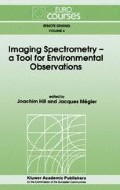Abstract
The effective use of remote sensing techniques requires a basic understanding of the fundamental processes that affect radiation during its transport between the source of light, the target of interest, and the detector. The principles of radiation emission and scattering in the optical domain are outlined, paying particular attention to the spatial, temporal, spectral, and directional sources of variability in the data. The problems of measuring and interpreting these observations are addressed, and the specifications of existing and planned space-borne instruments are discussed.
Access this chapter
Tax calculation will be finalised at checkout
Purchases are for personal use only
Preview
Unable to display preview. Download preview PDF.
8. References
Butler, D. (editor) (1987) ‘From pattern to process: The strategy of the Earth Observing System’, Report of the Eos Science Steering Committee, Vol II.
Curran, P. J. (1981) ‘Multispectral remote sensing for estimating biomass and productivity’, in: Smith (ed.) Plants and the daylight spectrum, Academic Press, London, 65–96.
ESA (1992) ‘The Medium Resolution Imaging Spectrometer (MERIS)’, Draft internal document, European Space Agency, 92 pp.
Estes, J. and M. Consentino (1989) ‘Remote sensing of vegetation’, in M. Rambler, L. Margulis, and R. Fester (eds.) Global ecology, Academic Press, New York, 75–111.
Freden, S. and F. Gordon, Jr. (1983) ‘Landsat satellites’, in R. Colwell (ed.) ‘Manual of Remote Sensing, Vol. 1’, American Society of Photogrammetry, Falls Church, 517–570.
Houghton, J. (1986) ‘The Physics of Atmospheres’, Cambridge University Press, Cambridge, 271 pp.
NASA (1986) ‘Data and information system: Report of the EOS Data Panel’, in Earth Observing System, Vol IIa, NASA Technical Memorandum 87777, Washington, 49 pp.
Kaufman, Y. and D. Tanré (1992) ‘Atmospherically resistant vegetation index (ARVI) for EOSMODIS’, IEEE Transactions on Geoscience and Remote Sensing 30, 261–270.
Kidwell, K. (1991) ‘TCOAA Polar Orbiter Data Users Guide’, US Department of Commerce, NOAA, Washington.
Neckel, H. and D. Labs (1984) ‘The solar radiation between 3300 and 12500 A’, Sol. Phys., 90, 205–258.
Norwood, V. and J. Lansing (1983) ‘Electro-optical imaging sensors’, in R. Colwell (ed.), Manual of Remote Sensing, Vol. 1, American Society of Photogrammetry, Falls Church, 335–367.
Pagano, T. and J. Young (1992) ‘MODIS-N Instrument Status’, Santa Barbara Research Center, Document 92-0257-1, Hughes Corporation.
Rees, W. (1990) ‘Physical Principles of Remote Sensing’, Cambridge University Press, Cambridge 247 pp.
Robinson, B. and D. DeWitt (1983) ‘Electro-optical non-imaging sensors’, in R. Colwell (ed.), Manual of Remote Sensing, Vol. 1, American Society of Photogrammetry, Falls Church, 293–333.
Rozelot, J.-P. (1973) ‘La Couronne Solaire’, Doin, Paris, 144 pp.
Sellers, W. (1965) ‘Physical Climatology’, Chicago University Press, Chicago, 272 pp.
Simonett, D. (1983) ‘The development and principles of remote sensing’, in R. Colwell (ed.), Manual of Remote Sensing, Vol. 1, American Society of Photogrammetry, Falls Church, 1–35.
Slater, P. (1983) ‘Photographic systems for remote sensing’, in R. Colwell, (ed.), Manual of Remote Sensing, Vol. 1, American Society of Photogrammetry, Falls Church, 231–291.
Pinty, B. and M. M. Verstraete (1992) ‘GEMI: A non-linear index to monitor global vegetation from satellites’, Vegetatio, 101, 15–20.
Vogt, J. (1992) ‘Characterizing the spatio-temporal variability of surface parameters from NOAA AVHRR data: A case for Southern Mali’, Ph.D. Thesis, Trier University, 216 pp.
Author information
Authors and Affiliations
Editor information
Editors and Affiliations
Rights and permissions
Copyright information
© 1994 ECSC, EEC, EAEC, Brussels and Luxembourg
About this chapter
Cite this chapter
Verstraete, M.M. (1994). Scientific Issues and Instrumental Opportunities in Remote Sensing and High Resolution Spectrometry. In: Hill, J., Mégier, J. (eds) Imaging Spectrometry — a Tool for Environmental Observations. Eurocourses: Remote Sensing, vol 4. Springer, Dordrecht. https://doi.org/10.1007/978-0-585-33173-7_2
Download citation
DOI: https://doi.org/10.1007/978-0-585-33173-7_2
Publisher Name: Springer, Dordrecht
Print ISBN: 978-0-7923-2965-7
Online ISBN: 978-0-585-33173-7
eBook Packages: Springer Book Archive

